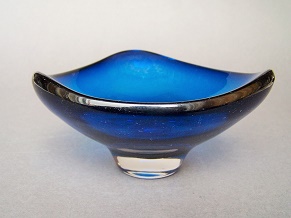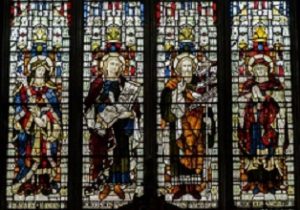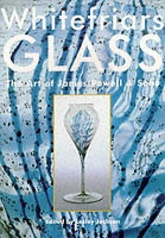
I don’t suppose that Whitefriars glass of James Powell was ever so popular and as big a name among glass collectors as it has been over recent years. Recognition of the good quality Whitefriars glass of Harry Powell and the more in demand and unusual modern Whitefriars glass of Geoff Baxter are of course the main reasons for this popularity.
The elegant Harry Powell pieces of the last century were always eagerly collected by those who appreciated and knew how to recognise them. Probably the recent popularity is more due to the designs by Geoff Baxter being so radical and the high prices being paid by dealers and collectors to acquire these pieces today. It would be interesting, if it were possible, to hear the thoughts of James Powell who originally acquired the company back in the early 1800s.

Most families, certainly those living in the UK will have had a piece of Whitefriars in their homes over the years without ever realising what it actually was. The image opposite is an example of a modern piece which could easily have been given as a wedding present in the 1960s and 70s.
Very few would have been privileged enough to have owned a Geoff Baxter Banjo vase or the larger version of the very distinctive Drunken Bricklayer vase. Although Geoffrey Baxter designed many other less well-known pieces as did the many other designers who worked at Whitefriars, they don’t command the same prices as these larger textured pieces.
The James Powell factory produced a lot of glassware and had a long history of glassmaking prior to its eventual closure in 1980. Glass as a material is well known for its brittleness if mistreated or dropped and it’s surprising how many of these older pieces are still being used or displayed in homes today. Possibly a testimony to how well they have been loved and appreciated.
Let’s go back about 200 years or so and look at a brief history about how this large important manufacturer first got started.
James Powell & Sons Takes Over Whitefriars Glassworks
 Most serious collectors of Whitefriars glass are well aware of the story behind the Powell family who acquired the works in 1834. Therefore, this post will only touch on the main points of the history of the company. Hopefully it will help those unfamiliar with the company’s history and those new to collecting Whitefriars glass to learn some of the basics.
Most serious collectors of Whitefriars glass are well aware of the story behind the Powell family who acquired the works in 1834. Therefore, this post will only touch on the main points of the history of the company. Hopefully it will help those unfamiliar with the company’s history and those new to collecting Whitefriars glass to learn some of the basics.
The history of the original glassworks in the Whitefriars area of London is a bit sketchy although the “Whitefriars Glass book – James Powell & Sons of London” goes into the topic in great depth.
James Powell acquired the company from the then owner William Holmes in 1834 and the records they have kept over all those years have provided us with a great insight of their glassmaking activities. Their pattern books allow us as collectors, to attribute many unknown pieces as being items made by Whitefriars.
Anyone can admire the beauty of a well-made piece. None more so than the avid collector who will continually be on the lookout for that missing piece to complete a collection. If there is such a thing as a completed collection to a glass collector!
Thanks to the Powell records it has made Whitefriars one of the most collected glassware’s, certainly in the United Kingdom. My introduction to this hoard of information was the visit to the Manchester City Art Galleries in 1996. Here we were treated to a huge display provided by, former workers, from museum collections and of course the Powell factory archives.
 In addition to the book I mentioned earlier which I purchased; I did buy another great book at that time. It was “Whitefriars Glass – The Art of James Powell & Sons” edited by Lesley Jackson. Check it out at the link above.
In addition to the book I mentioned earlier which I purchased; I did buy another great book at that time. It was “Whitefriars Glass – The Art of James Powell & Sons” edited by Lesley Jackson. Check it out at the link above.
This is a more condensed version of the larger London Museum book, but the photographs have proven priceless and are my memories of the examples viewed at the exhibition.
Although it would be impossible to display all Whitefriars pieces together in one place the book acts as a great reference for checking out, if a piece is Whitefriars or not. Viewing the numerous examples and colour variations can help avoid making costly errors in your purchases.
If contemplating building a collection and looking for Whitefriars glass for sale in the UK, read through my other post.
The Whitefriars Glass of James Powell
Apart from the stained glass, much of the items produced at Powell and Sons was mostly indistinguishable from other wares produced in the country. That was for around the first 30 years of its existence until the international Exhibition of 1862 took place. The exhibition allowed the Powell family to display a huge range of their wares including their new Venetian range made in an opal glass.
Critics of the time liked this new range although they felt that it lacked the colour of the original Venetian glass. However, it was a start to producing better designed items.
 Whitefriars Glassware by Harry PowellDesigners at Whitefriars around this time were. Philip Webb, T.G. Jackson, Joseph Leicester and of course Harry Powell. Harry was the son of Nathanael Powell and grandson of the founder James Powell. Harry went on to produce most of the designs for the company for about 40 years.
Whitefriars Glassware by Harry PowellDesigners at Whitefriars around this time were. Philip Webb, T.G. Jackson, Joseph Leicester and of course Harry Powell. Harry was the son of Nathanael Powell and grandson of the founder James Powell. Harry went on to produce most of the designs for the company for about 40 years.
From 1880 until 1919 he was exceedingly industrious. His designs of lighting and tableware’s in the Arts and Craft style were some of the best produced in the whole of Europe.
Many Venetian inspired vases in a straw opal and blue opal glass were made. Latticino threading, internal trailing, external trailing decoration and even metal mounts were all used in his designs.
The beautiful “Glasses with Histories” series so much associated as being designed by Harry Powell were actually started by his elder cousin James Crofts Powell. James while visiting Dutch museums made drawings of these historical pieces. They were exhibited in 1889 as the “Twelve Reproductions from Studies in Holland by Jas C Powell”.
The First World War was more or less responsible for bringing to an end the Arts and Crafts era and Harry Powell died in 1922. Before his death however he had made plans for the factory to be moved to Wealdstone where it remained till its closure in 1980.
The Final 60 Years of Whitefriars Glass – The Move to Wealdstone
 Some of the more popular designs from the Glasses with Histories range were still being produced well into the 1920s and the 30s. Obviously there was still a demand for these beautiful pieces. Opposite is a Woodchester vase designed by Harry.
Some of the more popular designs from the Glasses with Histories range were still being produced well into the 1920s and the 30s. Obviously there was still a demand for these beautiful pieces. Opposite is a Woodchester vase designed by Harry.
The journeys of Harry Powell and James Crofts Powell to museums in the UK and Europe resulted in numerous designs being produced. Although, I believe that not all designs were reproduced or, have not yet been seen.
Things at Whitefriars slowed in the 1920s which is not surprising. Apart from the war recovery, there was also the move to the new factory at Wealdstone and the loss of the exceptional designer and workaholic Harry Powell.
They continued to exhibit and showed their wares at the, Exposition Internationale des Arts Décoratifs et Industriels Modernes held in Paris. Here they manged to pick up a gold medal. It was probably at an, Exhibitioner in Leipzig in 1927 that their shapes in a simpler modern style were first seen.
The variety of examples produced in the 20s, 30, and 40s were many. They were streaky colours, wave ribbed, cloudy, cloudy striped, cloudy lattice, threaded, threaded ribbed, ribbon trailed and optic ribbed. Applied decoration of tears, spots, heavy ribbon trailing, swags, bubbled ribbon trailing were all used to decorate vases and bowls and on some lamp bases.
Plain vases were also produced, some with a rigaree foot ring. An interesting range was the lotus flower shapes that had vases and bowls representing the various stages in the flower’s life.
Tom Hill glass blower and designer was the first to produce really heavy thick-walled pieces for Whitefriars. These were a stark contrast to other finer examples he designed which included bowls with ribbon trailing applied.
The 1930s saw the return of cutting at Whitefriars. New geometric abstract cut patterns were designed and cut into a good selection of vases and bowls. Designers of these pieces were, William Wilson, Barnaby Powell and Albert Tubby. The former two in this trio were responsible for most of the designed during this period.
Stylish sherry sets, wine sets, cocktail sets jugs and tumblers and other tableware were also produced at this time, some with fine cutting and trailing.
In the 1940s and 50s thick walled pieces similar to those produced by Tom Hill in the mid-30s were again in production and designed again by William Wilson and Barnaby Powell. This time in a variety of shapes. Some with applied decoration, some with bubbles and other heavy vases and bowls with deep cut patterns.
Another relatively unknown designer emerges at this juncture 1954- 57 who also has designed contemporary bowls and vases with cut decoration. Who was he? Yes, none other than an old friend we spoke about in the very first paragraph of this article, Geoffrey Baxter.
Introduction to Whitefriars Glass of Geoff Baxter
Cut glass, Geoffrey Baxter. I know, cut glass might not be the very first thing you expect to be designed by someone who produced some of the zaniest glass designs ever produced in the UK. Remarkable people can do remarkable things and Geoff Baxter was surely a remarkable man.
These cut examples are only a small fraction of the designs by Baxter. Other items include, cased pieces in what we now call molar vases and bowls with pulled up rims. Some were quite similar to items being produces on the continent by Paul Kedelv. Certainly, more restrained than those created by Kedelv, in true British tradition.
Other examples of Whitefriars glass by Geoff Baxter include, vases and bowl with a white enamel edge, soda glass vases in varying shapes, sizes and colour. And a wide range of other attractive cased designs in new modern colours.
Harry Dyer and William Wilson designed an unusual range of lamp bases and vases in a heavy knobbly cased glass and others in streaky colours in different shades.
 Then in 1966 Geoff Baxter created designs for his textured glass range and I’m certain you have heard the story, “While working at home in his garage”. These prototypes were to be viewed by William Wilson the chief designer at the time, on his return from holiday. It is said that Baxter was more than a little relieved to get the thumbs up for production of his designs.
Then in 1966 Geoff Baxter created designs for his textured glass range and I’m certain you have heard the story, “While working at home in his garage”. These prototypes were to be viewed by William Wilson the chief designer at the time, on his return from holiday. It is said that Baxter was more than a little relieved to get the thumbs up for production of his designs.
Those first few textured examples were soon to be expanded upon. They became the range of stunning pieces we all dream about owning today. If we only had the foresight to pick them up either brand new or second hand before the prices rocketed.
These textured shapes, from the bark vases to the more dramatic banjo vases, every one of them has that fresh new design look. Good designs always seem to look modern and as if they could have been produced today. Just like some of the Christopher Dresser designs, I believe these Baxter pieces will stand the test of time and be modern looking for generations to come.
Geoffrey Baxter went on to design other pieces with contrasting applied spots and ribbon trails and vases which were decorated with applied strapping in a random fashion. He also designed a new range of streaky glass vases and a range of paperweights.
Peter Wheeler an assistant to Geoffrey Baxter designed a range that was termed Studio Glass. Some were white lined with vertical stripes created by using silver chloride and then cased in clear. Another was the Peacock Studio range created using kingfisher blue and twilight with random strapping applied to the top areas. Silver chloride was again added to the strapping which altered the strapping colour. These designs were only in production for a year or so.
Thanks for Remarkable People and Remarkable Glass
As I mentioned earlier Geoffrey Baxter was surely a remarkable man. His large range of modern unusual designs will be testament to that. It’s probably quite easy for us to accept that he was indeed remarkable because he is of our time and we can relate to so much of what he did. But so, to were others in the Powell organisation.
James Powell, remarkable for having the insight to acquire the Whitefriars Glassworks. Remarkable for running a company that kept so many detailed records that we can use, study and enjoy today.
Harry Powell another remarkable man, who did so much for the company and left us with some truly beautiful examples of handmade Arts and Crafts glass. This at a time when all around them were mechanising and pumping out pressed glass items in their thousands. How many times, especially when times get tough, might the minds of those in charge of the business considered radical changes? I suspect they may have had thoughts about moving over to these new modern mechanical methods of the era.
The time-consuming art of producing each hand blown item by a chair (gaffer and team) would have been expensive compared to the mass produced pressed glass.
The remarkable workers. Those in the chairs and other members of staff who stuck to the task through those more difficult bygone eras and their families who depended on them.
The remarkable creators of the books “Whitefriars Glass book – James Powell & Sons of London” by Wendy Evans, Catherine Ross and Alex Werner. The “Whitefriars Glass book – James Powell & Sons of London” by Wendy Jackson.
To the organisers of the event held in the Manchester City Art Galleries in 1996 who put on such a remarkable display. Not forgetting the contributors who amassed around 900 pieces of Whitefriars from 1860s to the 1970s.
Thanks also goes to Rodger Dodsworth of the Glass Cone and Broadfield House Glass Museum for the invitation to the Whitefriars glass event during my membership. All of those people mentioned above in my view, are truly REMARKABLE!!!